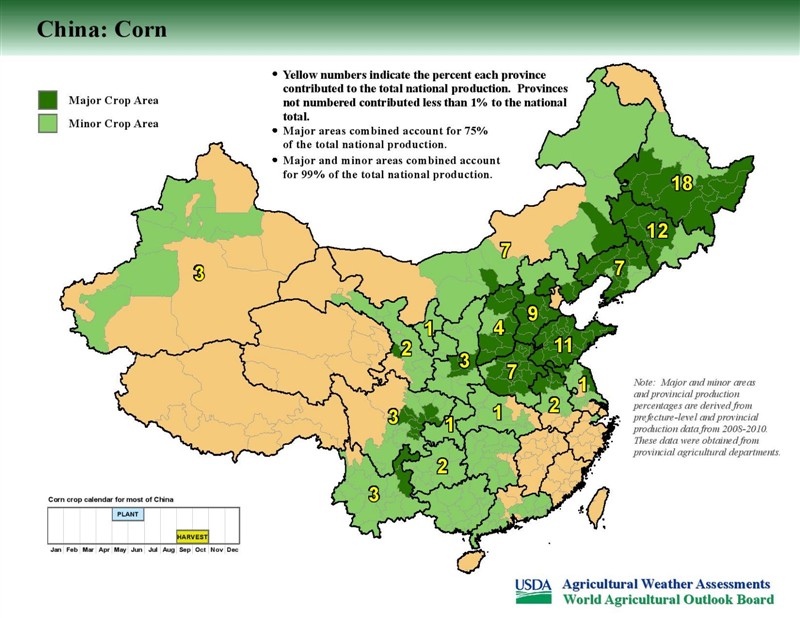|
| Fatan Sassy posed a question about how China could respond to the restriction of the US supply. We already know that China has responded to the potential of tariffs for some months by switching subsidies from corn to soybeans and already anticipated an 8% increase in soybean acres. Plus China has a roughly 200 million metric tonne corn stocks that they wanted to reduce anyways. Given that rice is grown under quite different conditions, it's seems unlikely they would divert rice crop area to soybeans.
An initial review includes the following for wheat,60 million acres, 129 million metric tonnes; Corn 88 million acres, 212 million metric tonnes; soybeans, 19 million acres, 20 million metric tonnes, respectively.
Below are three charts which show the crop growing areas for these crops. It's readily apparent that soybean crop areas overlap with both corn & wheat. Maybe not so surprisingly, soybean acres already extend into wheat growing areas, similar to what we see here in the US. So they have roughly 150 million acres of corn & wheat which to switch to soybeans. And they have corn stocks roughly equivalent to a year's supply to rely on, at least in the short term.
The next question is: what adjustments in supplies are necessary? China's domestic production is 20 MMT and imports 95MMT. We know that US exports to China have fallen from 33 to 27 MMT (6-7 MMT) and that Brazil's total exports have increased from 63 MMT to over 70 MMT (7 MMT). It's reasonable to believe that the majority of those Brazilian exports may have gone to China. So Brazil has already replaced 25% of the US exports to China.
So the question becomes, what happens if China increases it's soybean area by 25% as opposed to just 10%. That's 5 MMT increase in domestic supply and that cuts any shortfall from 25 MMT to 20 MMT. And more importantly that they will have that domestic production available to them this fall.
Now some people are saying that the "Chinese still need to eat". My question is do we actually have all that much leverage in this situation? And my sense is, this is beginning to look more and more like the Russian Grain Embargo where it turned out that the Russians weren't actually all that inconvenience and in fact, triggered expanded domestic grain production.
Edited by farmer4321 7/9/2018 07:04
 (china soybeans (full).jpg) (china soybeans (full).jpg)
 (China_Corn-page-001 (full).jpg) (China_Corn-page-001 (full).jpg)
 (China_Wheat-page-001 (full).jpg) (China_Wheat-page-001 (full).jpg)
Attachments
----------------
 china soybeans (full).jpg (123KB - 163 downloads) china soybeans (full).jpg (123KB - 163 downloads)
 China_Corn-page-001 (full).jpg (118KB - 177 downloads) China_Corn-page-001 (full).jpg (118KB - 177 downloads)
 China_Wheat-page-001 (full).jpg (120KB - 170 downloads) China_Wheat-page-001 (full).jpg (120KB - 170 downloads)
| |
|


 Sassy's question.
Sassy's question.